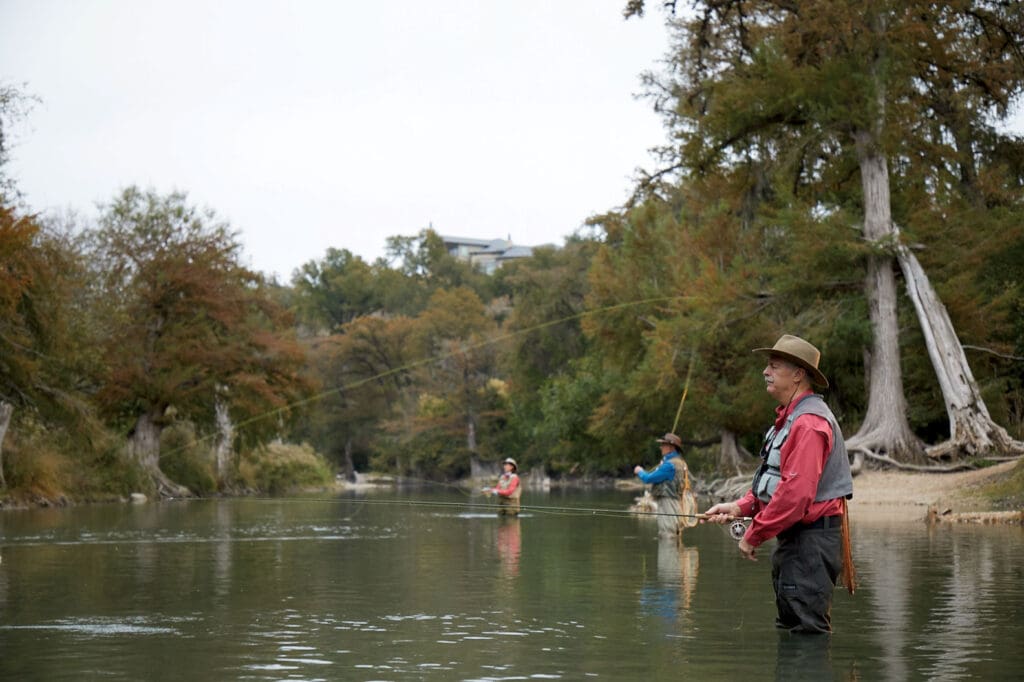Taking care of the natural resources within Cordillera Ranch, which face increasing pressures and demands from a growing community, is a task that requires everyone to lend a hand at whatever level they can. This topic comes to my mind often as I travel around the Ranch to our different Club facilities and parks and see the tremendous growth that has taken place over my sixteen years here.
By:
Shane Reynolds, Outdoor Recreation Director and Outfitter
 I recall a message I received from a Cordillera Ranch property owner, who proceeded to tell me there was a lot of broken glass at the park on the shores of the Guadalupe River where we launch kayaks. The location is also a great place for young kids to enjoy the banks of this beautiful waterway. When I arrived, I was shocked to see approximately 12 beer bottles shattered into hundreds of pieces on the edge of the river. As I proceeded to slowly pick up all the glass, my mind drifted to wonder who might be so compelled to trash such a pristine environment? I thought, yes, we were all teenagers at some point, but for some reason I never would have considered breaking glass next to a river.
I recall a message I received from a Cordillera Ranch property owner, who proceeded to tell me there was a lot of broken glass at the park on the shores of the Guadalupe River where we launch kayaks. The location is also a great place for young kids to enjoy the banks of this beautiful waterway. When I arrived, I was shocked to see approximately 12 beer bottles shattered into hundreds of pieces on the edge of the river. As I proceeded to slowly pick up all the glass, my mind drifted to wonder who might be so compelled to trash such a pristine environment? I thought, yes, we were all teenagers at some point, but for some reason I never would have considered breaking glass next to a river.
One of the best places to begin to teach kids about conservation and stewardship is right where you live. Whether it’s a 2-acre lot or a 50-acre estate, your “backyard” is an important part of a larger natural community and ecosystem. The large expanse of neatly trimmed turf that’s pleasing to some is a very inhospitable environment for wildlife, and the practices necessary to maintain such a landscape often contribute to water quality and quantity problems. By making different landscaping choices, property owners can do their part to assure healthier habitats and cleaner creeks and lakes. One the great benefits of living in Cordillera Ranch is the fact that most of the property is required to remain in its natural state with native grasses that flourish in the Texas Hill Country.
Teaching stewardship, conservation and environmental ethics to children can often be challenging. Can you teach someone how to act in the outdoors? Not really. However, you can make them aware of the consequences of their actions. You can also lead by example and show them what they can do to promote the conservation of our natural resources and the creatures that live there.
Be sure to always give your kids and grandkids unfettered time in the natural world — time away from organized sports or adult-directed activities. Give them lengthy time to explore and play outside. It might take the form of building a fort from found objects, damming a creek or collecting natural objects like shells, rocks or acorns. These moments in nature are an important way for kids to develop a strong connection to nature and the environment. Here are a few tips you may find helpful in passing on key messages of conservation and ethics to the next generation who call Cordillera Ranch home.
We’ll use fishing as an example. You can begin by engaging your kids in a discussion of ethical dilemmas they may face while fishing at Swede Creek Lake or the Guadalupe River. Some of these dilemmas will include catch and release, environmental responsibility, the use of barb-less hooks, etc. Consider presenting an issue and then give an ethical solution to that issue.
A good rule of thumb is to remember that ethics are caught, not taught. So set a good example when you take youngsters or guests fishing. Here’s a good role model activity: place a plastic bag in your pocket while fishing at Swede Creek Lake or the Guadalupe River. Without saying a word, begin to walk around and pick up trash. The children and guests hopefully should start to copy your actions and eventually start helping with the clean up. Another thing you can do is practice catch and release. Explain that wetting your hands when handling fish helps minimize the damage to the fish’s protective slime.
Passing on good conservation habits and ethics can be challenging. However, the benefits to fish and wildlife are extremely important. Discussing with children and guests the consequences of incorrect actions and how those actions can hurt wildlife is a starting point. As a resident of Cordillera Ranch, you have the opportunity, one by one, child by child, guest by guest, to set an example for future generations to follow as they begin to enjoy the wonderful environment of Cordillera Ranch and the great outdoor resources on the Ranch.
A final suggestion to promote conservation: if you are building at Cordillera Ranch, talk to your builder and sub-contractors about taking ownership of your construction project with a good environmental perspective on stewardship. The construction parameters that Cordillera Ranch have in place are stringent and that’s on purpose — to protect this beautiful environment that we all love. Be sure they follow the rules and keep the construction site clean and neat and protect the native areas of your land.
Shane Reynolds is the Outdoor Recreation Director and Outfitter at The Clubs of Cordillera Ranch. He can be reached at outfitter@cordilleraranch.com and 210.616.6051, or at the Cordillera Ranch Outfitter Center at 830.336.4823.








